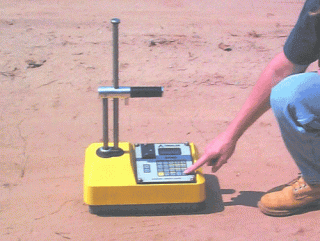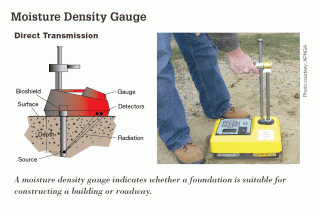Nuclear Gauges
- When properly used, nuclear gauges will not expose the public to radiation.
- Safety standards and guidelines are in place to limit radiation exposure of workers who use these gauges.
- Nuclear gauges must be used safely and disposed of properly.
Nuclear gauges use radioactive sources to identify the thickness, density or make up of a wide variety of material or surfaces.
These gauges, which are safe to use when the proper safety measures are followed, help people build safe buildings, roads, and make reliable products.
About Nuclear Gauges
The use of nuclear gauges is a type of industrial radiography. Radiography is the use of radiation to produce an image on photographic film. This is similar to the way a medical x-ray uses radiation to produce images of bones.
Nuclear gauges measure three main things: thickness, density, and fill level. Thickness gauges are used in manufacturing to make sure an entire product or material is the same thickness throughout, or to make sure the coating on a material is even. Density gauges are used in cement, petroleum, and road production to make sure that the density of a material is the same. Level gauges measure how much liquid is in a container, to make sure that each container has the same amount of product.
Source: U.S. Department of Transportation (DOT)
Nuclear gauges have a radioactive source that is covered by a radiation blocking shield. Gauges can contain a gamma, beta or neutron radiation source. Different sources are used depending on what the nuclear gauge is measuring. Radiation from a nuclear gauge does not make the materials it measures radioactive.
Nuclear gauges are either fixed or portable. Fixed nuclear gauges are permanently mounted in a location. Typically, objects pass by the fixed gauge on a conveyor belt for inspection. On the other side of the object is a radiation detector. When the radioactive source is opened, radiation is emitted from the gauge and some of the radiation will pass through the object. The rest of the radiation is absorbed by the object. Any radiation that is able to pass completely through the object will be measured at the detector. Usually, fixed gauges are used to ensure that each item passing by the gauge is the same.
Portable gauges are commonly used in industries such as agriculture, construction and civil engineering. They are useful because they can be transported from one site to another. Portable gauges work in a similar way to fixed gauges, but because they are not permanent, both the radioactive source and the detector need to be able to move. Sometimes, parts of the gauges are inserted into the ground in order to get an accurate measurement.
Source: U.S. Nuclear Regulatory Commission (NRC)
Nuclear gauges are designed with worker safety in mind. All nuclear gauges should be properly marked to let you know they contain radioactive materials. The devices are lined with a lead shielding around the sealed source of radiation, which shields the environment from radiation. When in use, the shield should only be open when taking active measurements. The shield is closed when the gauge is not in use. Workers usually receive little or no radiation from nuclear gauges due to the safety measures in place. When properly used, nuclear gauges will not expose the public to radiation.
When no longer in use, nuclear gauges must be stored safely. Safe storage locations should be fireproof and weatherproof. Nuclear gauges may only be disposed of in specific locations and should not be treated as ordinary trash. Gauge manufacturers or state radiation control program staff can provide disposal instructions. Some manufacturers also accept gauges for disposal.
What You Can Do
- Do not handle broken equipment. If you believe that a nuclear gauge is broken, do not attempt to handle it yourself. Never handle an unshielded radiation source. Call local authorities immediately and report it. People who work with nuclear gauges know the appropriate steps to ensure proper management.


